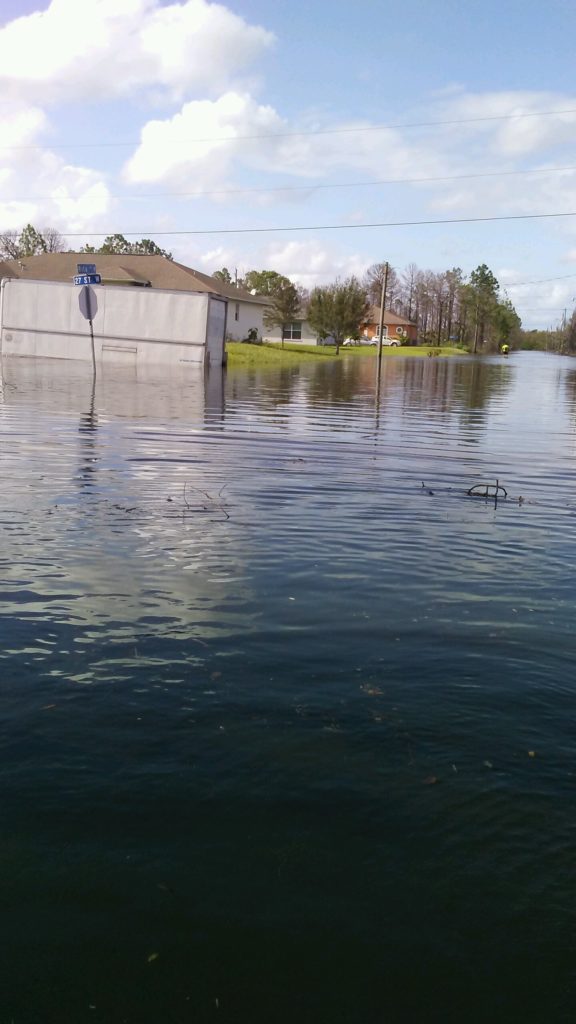“Oh my God, there’s mashed potatoes!”
A young boy with a big grin grabbed the Styrofoam plate and its too-good-to-be-true offerings—chicken, green beans and those mashed potatoes—and disappeared back into the night.
From the pickup trucks hauling the bounty, his reaction delighted volunteers who, in a spur-of-the-moment decision, had wrapped, boxed and loaded more than 200 meals leftover from a community dinner at Lehigh Senior High School and trucked them to Charleston Park, one of Lee County’s most impoverished communities—and probably its most forgotten.
 |
|
Volunteers, including Lehigh Senior High staff and students, finish serving a meal with the Salvation Army and Southern Baptist Emergency Relief and then prepare leftovers for the Charleston Park neighborhood. |
The neighborhood is a blip on the map, on the Lee/Hendry line off of State Road 80. A mere 146 people are estimated to live there, according s of the Census’ 2015 American Community Survey. The median household income is $16,000; 33 percent of residents are below the poverty line; not one adult over the age of 25 has a college degree. It’s the kind of place where a young black man puts his hands up when he spots the sheriff’s cruiser escorting the volunteers and where neighbors move indoors as flashing lights approach.
Now, on top of those day-to-day realities, comes the aftermath of Irma.
“It’s bad out there,” says Jackie Corey, the high school principal, who, along with staff members Kevin and Portia Clapper and Jaclyn Plucker, had made a run to Charleston Park previously. A couple of LSHS students live out there. “We’d gotten an alert that people in Charleston Park didn’t have any food.”
Hence why Corey, the Pluckers, several other school district colleagues and a couple of Salvation Army officials decided to bring the night’s leftovers there.
“Thank you, thank you,” one man says, accepting plates to hand out. “There’s people out here who can’t help themselves.”
Charleston Park is a unique case, but it’s only one of many stories emerging from Lee County’s heavily damaged eastern side. Earlier that night, in the school cafeteria, residents told their war stories—about the storm and the mess left behind.
“This is my house just before the storm,” says Celia Camacho. The photos showed puddles typical of a Florida summer rain. “When I got home, it was like a swimming pool.”
Her manufactured house withstood the winds reasonably well—better than many, she says. She and her family had come for a hot dinner and also received a box of prepackaged meals. Of these, her 7-year-old niece Jasmine Vanegas chimes in: “The man in the red vest says there’s Skittles in that box!"
A few tables over, Daniel Christy of Buckingham smiles in good humor. “Well, today it’s not so bad. (The water is) at my knees. Before it was at my chest.”
He was able to get out of his house in his brother’s oversized truck, but others had to wait for help. “I never expected to see the National Guard come down my street,” he says.
The power is still out in many homes, and along with it, well pumps and septic tanks. Ice is hard to find, and no one wants to spend precious gas looking for it. One woman says FEMA has already turned down her application. Another, whose husband recently died, is single-handedly managing five children, three of whom have disabilities. Still another is trying to keep her foster children, all elementary-aged or younger, entertained in a house with no power. She is grateful the school opened its gym for the children to play.
“I am tired,” admits another Lehigh resident, Edna Jones. She’s 56 and disabled from an injury. Her husband is recovering from a surgery just before the storm. She shows photos from her home—water damage, cracked stucco, smashed light fixtures and missing roof tiles. Her living room sectional stinks from its drenching. She lost all the food in her fridge and deep freezer.
 |
|
Lehigh Senior High Principal Jackie Corey and Julee Duttko, a friend and assistant principal at North Fort Myers Academy for the Arts, with a Charleston Park resident. |
“We need to regroup and get our lives back,” she says.
The school where the residents gathered had itself taken a beating—tree limbs down, a foot of water in the front office, 3 feet in the auditorium, destroyed ceiling tiles in such number that it took a 15-person custodial team two days to clear them out.
Two teachers lost much of their homes—faculty rushed to one of them to pull out drywall before mold took root. Other staff manned a massive campus cleanup or showed up to serve the Salvation Army dinners.
“I have the most amazing people in the world,” says Corey, the principal. “We are family.”
And that’s just at one school. All 94 Lee County public schools took a hit, some worse than others, according to the school district’s website. Some schools that served as shelters were stuck cleaning the human and animal messes left behind. Administrators and faculty in many cases had taken on the task, says school board member Pamela LaRiviere, while visiting the community dinner at Lehigh Senior.
“We’re talking major cleanup at some of these places,” she says.
Collier County Public Schools are suffering much the same. A district update posted today, Saturday, shows that just 26 of 54 schools have power; county sewage issues are causing backups in the schools even while not in use; and 29 schools used as shelters needed deep cleaning and disinfecting, among other issues.
Both school systems anticipate opening on Monday, Sept. 25. For updates, visit leeschools.net and collierschools.com.





